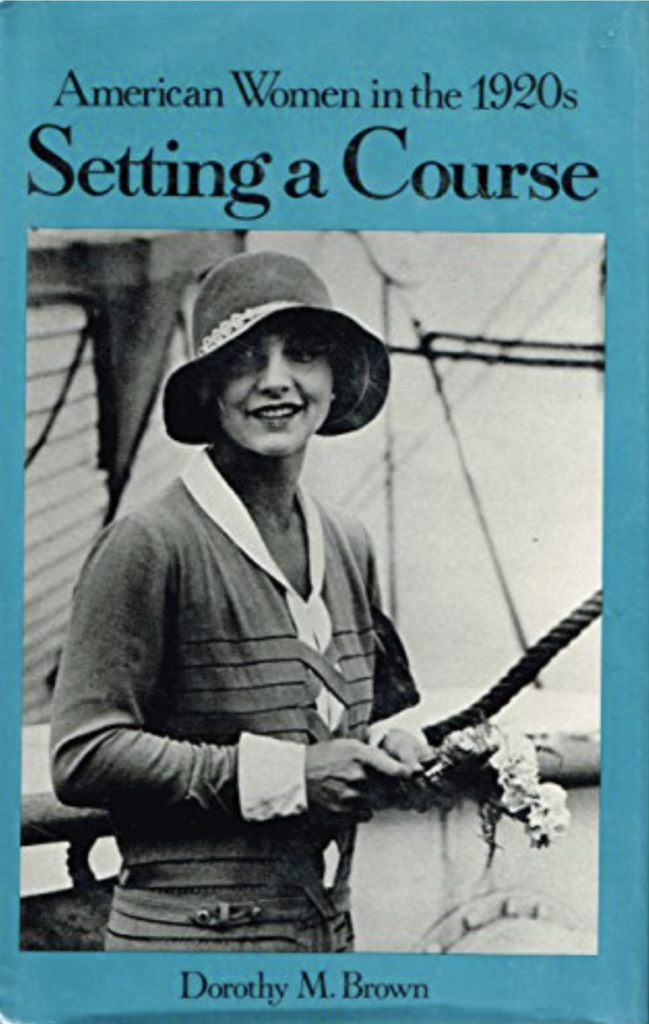
Summary
Dorothy M. Brown’s novel titled “Setting A Course: American Women in the 1920s” was written in 1987 and goes into depth regarding the roles that women held throughout the 1920s. Throughout her book she uses scholarly sources relevant to the time of publishing and primary sources to support her thought-provoking writings and main scope of her topic on women’s roles. Brown emphasizes that the evolution of the woman, commonly referred to as the “New Woman” was somewhat compartmentalized, boxed up and left to be. However, Brown signifies the diversity that many women embraced into their lives. It describes how there was a great deal of excitement for the possibilities for women after the ratification of the Nineteenth Amendment but the inequality between men and women continued to linger.
How Does it Fit Into the Larger Historiography of the 1920s?
“Setting A Course: American Women in the 1920s” is significant to the larger historiography of the 1920s because it demonstrates the diversity of roles that women began to receive during this time period. As discussed in my two other posts on women’s rights, “Evolution of Women’s Roles in India” and “Ida B Well’s Role in Women Suffrage,” it was throughout this decade that the traditional roles of a woman shifted and began to evolve. The initial thought that many have when initially thinking about the 1920s is the dominance of flappers, which were young women that were highly confident and often lived a life that at the time was seen to be outrageous and shopping. The Flappers paved the way for women to demand economic, political, and sexual freedoms for themselves. However, this opened up to the diversity of women’s roles which is exactly what Brown’s book discusses. It can be related to Paula S. Fass’s “The Damned and the Beautiful: American Youth in the 1920s” as Fass focuses her novel on how the youth of America experienced a shift in their own roles, as well as how the relationship between a man and a woman evolved. Brown’s novel relates to Fass’s novel as Brown’s takes essentially is taking a more specific section on women of Fass’ while focusing on women’s roles and developed that idea into her own novel. A few years after Brown’s novel published in 1987, Lynn Dumenil wrote: “The Modern Temper American Culture and Society in the 1920s” which took a broader stance on the misconceptions of the 1920s and how there was a much deeper cultural shift that took place, which likely encompasses some of Brown’s general thoughts on a woman’s role in society.
What Does it Provide to a Reader Interested in the 1920s?
Dorothy M. Brown’s “Setting A Course: American Women in the 1920s” provides readers a new look on women’s roles during the 1920s and how they have evolved from the traditional stereotype of women being only the housewives. Not only does it work to educate reader’s on women’s roles, but it introduces a broader issue of what is thought of as the key events and occurrences of the 1920s. There are many significant contributions that took place during this decade and it is important to note significance to each of them. However, in undergraduate studies, this decade is not very focused on thus leading students to form misconceptions based on the “Great Gatsby,” which is a great novel, however, not the sole focus of what this time period was like. Reading Brown’s book is one way for readers to begin educating themselves on the 1920s and the significance of this era.
Resources
Brown, Dorothy Marie. “Setting a Course: American Women in the 1920s.” Google Books. Twayne. Accessed May 12, 2021. https://books.google.com/books/about/Setting_a_Course.html?id=SxAqAAAAYAAJ.
Dumenil, Lynn. “The New Woman and the Politics of the 1920S.” OAH Magazine of History 21, no. 3 (2007): 22-26. Accessed May 12, 2021. http://www.jstor.org/stable/25162125.
Nichols, Carole, and Dorothy M. Brown. “Setting a Course: American Women in the 1920s.” The Journal of American History 75, no. 1 (1988): 294. https://doi.org/10.2307/1889761.

Angelina Farallo is a Law and Society Major at Ramapo College of New Jersey. Ever since she was in elementary school, history has always been her favorite subject. During her studies at Ramapo College, she has studied how the modernization of technology has affected various industries such as the law, and in this case history which is what drew her to take this Digital Humanities course.
